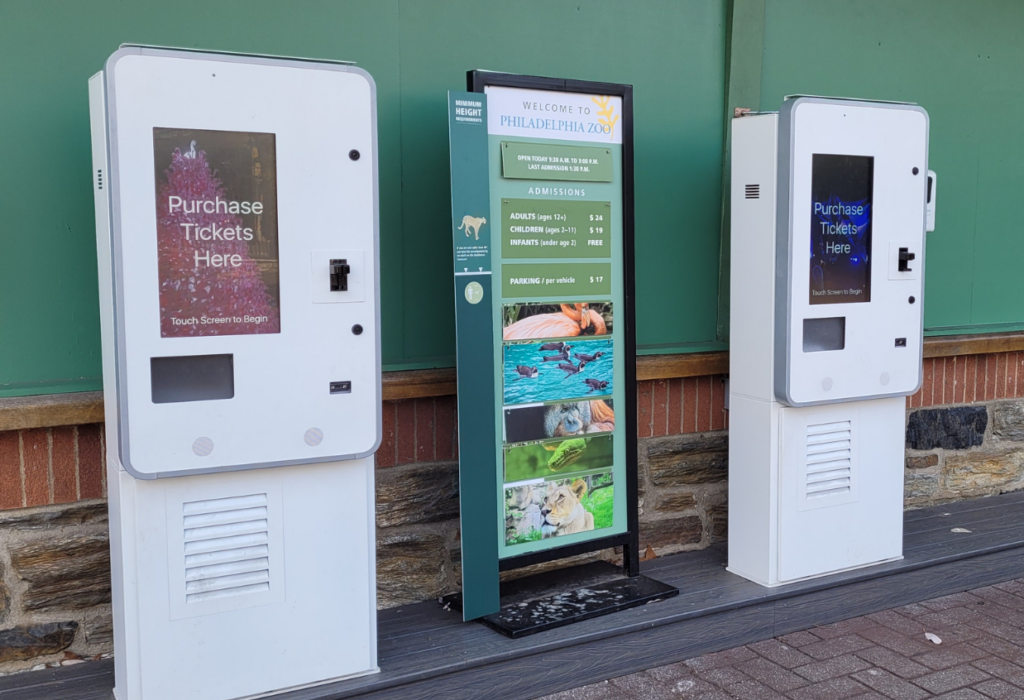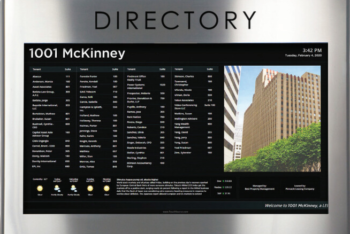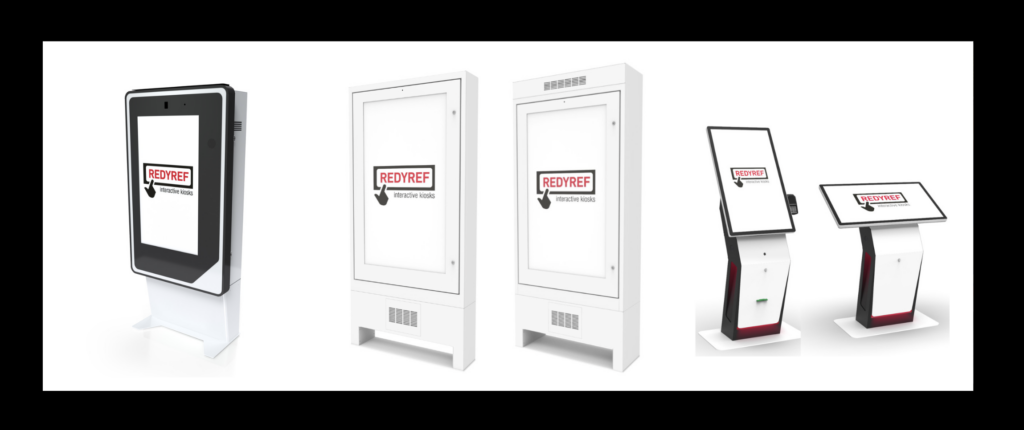Self-service kiosks, also known as self-serve kiosks or terminals, empower customers to independently perform transactions, access information, and complete tasks. They have transformed customer interactions, offering convenience and efficiency across industries. In this article, we will explore the features, benefits, and diverse use cases of self-serve kiosks, highlighting their impact on businesses and users, in particular, how they enhance the customer experience, leading to greater satisfaction and loyalty.

What Components Make Up a Self-Service Kiosk?
Self-service kiosks are cutting-edge interactive machines designed to empower users to perform transactions as well as access information independently. These technologically advanced kiosks feature intuitive interfaces, enabling users to effortlessly navigate through any number of different interactive options, and include specialized components such as:
- Touchscreen Displays: Self-service kiosks leverage user-friendly touchscreen displays, allowing users to interact directly with the interface. The touch-enabled screens respond to taps, swipes, and gestures, providing a familiar and intuitive way for users to engage with the kiosk. Larger kiosks generally use a display that is separate from the computer and other components, while smaller kiosks, such as those for simpler uses like queuing, may use a tablet or iPad, creating a more all-in-one solution.
- Kiosk Enclosure: Generally engineered and manufactured from stainless steel or ruggedized steel, depending on the environment in which the kiosk will be deployed. They are designed and fabricated based on the kiosk's use case, and may be rated for indoor or outdoor use.
- Kiosk Software: Self-service kiosk software is the "brain" that drives their functionality and performance. It enables seamless integration with hardware components, provides a user-friendly interface, and facilitates secure transactions. With features like data analytics and remote management, self-service kiosk software empowers businesses to deliver efficient and personalized interactive experiences to customers
- Hardware Components: Depending on the intended use case, self-service kiosks incorporate additional hardware components to enhance their functionality and cater to specific requirements. Some common hardware components found in self-service kiosks include:
-
- Barcode Scanners: Enable users to scan product barcodes or tickets for quick and accurate identification. This feature is especially beneficial in retail, transportation, and ticketing applications.
- Card Readers: Allow users to conveniently make payments using credit or debit cards, providing a secure and efficient transaction process. They are commonly found in retail, hospitality, and self-checkout kiosks.
- Printers: Enable users to receive physical receipts, tickets, or vouchers after completing transactions or registrations. This feature is especially common in industries such as retail, healthcare, and transportation.
- Cameras: Can be incorporated into self-service kiosks to support functionalities like ID verification, document scanning, or capturing images for identification purposes. This is particularly useful in applications such as airport check-ins, visitor registration, and self-service printing.
These hardware components complement the intuitive user interface of self-service kiosks, offering a seamless and efficient self-service experience to users across different industries.

5 Features of Well-Designed Self-Serve Kiosks
- Intuitive User Interface (UI): Self-service kiosks prioritize user-friendly interfaces that guide customers seamlessly through the available options. The intuitive touchscreens feature clear instructions and simple navigation, ensuring that users can interact effortlessly with the kiosk, even without prior experience. The interface design takes into account user behavior and preferences, minimizing the learning curve and maximizing usability.
- Versatile Payment Options: One of the key advantages of self-serve kiosks is their ability to accommodate a wide range of payment methods, offering customers flexibility and convenience. Whether it's credit/debit cards, RFID, NFC, mobile wallets, or even cash, self-service kiosks enable users to make seamless transactions using their preferred payment method. This versatility ensures that customers can complete their purchases without hassle, enhancing their overall satisfaction.
- Real-Time Data and Information: Self-service kiosks excel in providing users with real-time information, enabling them to access up-to-date details about products, services, prices, promotions, and any other relevant data. Whether it's checking stock availability, comparing options, or gathering information about specific products, customers can rely on self-service kiosks to provide accurate and current information. This feature empowers customers to make informed decisions, fostering trust and enhancing their overall experience.
- Efficient Order Placement and Customization: In the food and beverage industry, self-service kiosks offer customers a streamlined and personalized ordering experience. These kiosks allow users to place their orders directly, bypassing long queues and minimizing waiting times. Moreover, self-service kiosks enable customers to customize their orders according to their preferences. From selecting ingredients, toppings, and condiments to specifying cooking preferences or dietary requirements, self-ordering kiosks ensure that each order is tailored to the customer's exact specifications. This level of customization not only increases customer satisfaction but also reduces order errors, as customers have full control over their preferences.
- Digital Signage Integration: Some self-service kiosks integrate dynamic digital signage capabilities, allowing businesses to display engaging and relevant content. By showcasing advertisements, promotions, or informative content on the kiosk's display, businesses can capture the attention of customers and enhance engagement. This feature serves as an additional revenue stream, as businesses can partner with third-party advertisers or promote their own products and services through the self-service kiosk's digital signage.

4 Benefits of Self-Service Kiosks
- Improved Customer Experience: The introduction of self-service kiosks revolutionized the customer experience by providing a quicker and more convenient way to complete transactions or access information. By reducing waiting times and allowing customers to control the pace of their interactions, these kiosk machines increase users' satisfaction levels. Customers appreciate the autonomy and efficiency that self-service kiosks offer, leading to increased loyalty and positive brand perception.
- Enhanced Operational Efficiency: Businesses can optimize their operations and allocate staff to more critical roles by offloading routine tasks to self-service kiosks. With self-service kiosks handling tasks such as checkouts, information lookup, or registrations, businesses can streamline processes, reduce bottlenecks, and improve overall efficiency. This not only saves time but also reduces labor costs and enables employees to focus on delivering higher-value services, such as personalized assistance or problem-solving.
- Increased Sales and Revenue: Self-service kiosks have the potential to significantly impact sales by creating upselling and cross-selling opportunities. Through targeted prompts or suggestive selling techniques integrated into the self-service kiosk interface, businesses can encourage customers to explore additional products or services. This approach leads to increased customer engagement, higher average transaction values, and ultimately, increased revenue. Self-service kiosks act as effective sales assistants, leveraging data-driven recommendations and enticing visuals to drive customer purchases.
- Data Collection and Analytics: One of the significant advantages of self-serve kiosks is their ability to collect valuable data and provide detailed analytics. By capturing customer behavior, preferences, and transaction patterns, businesses can gain actionable insights. These insights allow businesses to make data-driven decisions, optimize their operations, and personalize offerings based on customer trends. Through data analysis, businesses can identify areas for improvement, fine-tune their marketing strategies, and create targeted campaigns that resonate with their customer base.

4 Popular Self-Serve Kiosk Use Cases
- Retail and Hospitality: Self-service kiosks find extensive use in retail stores and hotels. They enable customers to perform self-checkout, access product information, book services, or complete room check-ins. These kiosks streamline processes, reduce queues, and enhance the overall customer experience by providing convenience and control over transactions and inquiries.
- Transportation Ticketing: Transportation hubs such as airports and train stations leverage self-service kiosks for various ticketing processes. Travelers can purchase tickets, check in, print boarding passes, and tag baggage using self-service kiosks. This automation expedites the passenger journey, reduces lines, and simplifies ticketing procedures, resulting in a more efficient and hassle-free travel experience.
- Healthcare and Pharmacy: Self-service kiosks in healthcare settings streamline administrative processes and enhance patient experience. Patients can check in for appointments, schedule future visits, request prescription refills, and access medical information through self-service kiosks. These kiosks reduce waiting times, improve workflow efficiency, and empower patients to take control of their healthcare interactions.
- Quick-Service Restaurants (QSRs): Quick-service restaurants are increasingly adopting self-service kiosks to enhance the ordering process. Customers can place their orders, customize their meals, and make payments directly through self-service kiosks. This automation speeds up service, reduces order errors, and empowers customers to tailor their dining experience according to their preferences, resulting in improved customer satisfaction and operational efficiency.
Self-service kiosks have become an indispensable tool for businesses across various industries, offering an efficient and personalized customer experience. With intuitive interfaces, versatile features, and benefits such as improved efficiency and increased sales, self-service kiosks continue to transform the way customers interact with businesses. By embracing this technology, organizations can meet the growing demand for self-service solutions and create a competitive advantage in today's digital landscape.
Interested in learning more about self-serve kiosks for your business? Contact REDYREF online today, or call 1-800-626-3603 for additional information.




